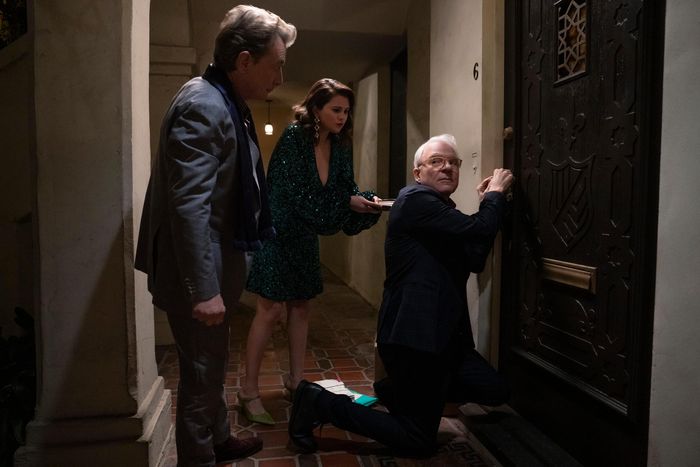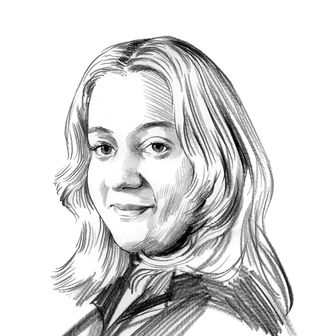
Even for a show with death in its name, the fourth-season premiere of Only Murders in the Building concludes in unusually brutal fashion: Charles-Haden Savage & Co. discovering the body of Sazz Pataki, Charles’s longtime stunt double, incinerated in the Arconia’s basement. We know that Sazz (Jane Lynch) was shot and killed in the final moments of season three, while hunting for a bottle of wine in Charles’s apartment to celebrate Death Rattle Dazzle’s opening night. But the crime scene is swiftly wiped clean, her body removed to avert suspicion and her phone sending curt messages about returning to Los Angeles for a job. This murder, clearly, was premeditated. But who was the killer targeting? Sazz and Charles (Steve Martin), of similar gait and style, could almost pass as twins. Was Sazz indeed the intended strike, or did Charles’s stunt double make the ultimate sacrifice in a case of mistaken identity?
All of these questions, and more, go through Charles’s mind in the episode’s wordless final sequence — his hands and jacket covered in Sazz’s cremains as he identifies her metal joints in the incinerator (the very nature of stunt work means Sazz has had many corrective surgeries, the X-rays from which she proudly displayed in her apartment). Mabel (Selena Gomez) and Oliver (Martin Short) are too stunned to offer anything other than dejected silence. “This is the darkest we’ve ever gone,” showrunner John Hoffman says. “It was always going to be this type of death once we landed on this notion of Sazz being a stunt double who had a lot of joints replaced. Charles is holding in his hands his friend and he knows it.” The medical pieces, stamped with her preferred country of origin — Bulgaria — confirm it’s unequivocally her. “I wanted to hold the center emotionally for him: I have to know, did I inadvertently get my beloved friend killed, who has done nothing but stand in for me?” A text to Charles interrupts the moment, the killer using Sazz’s cellphone to taunt that they’re “not your fucking friend.”
Hoffman knew early on that the heart of the fourth season would be the relationship between Charles and his Hollywood stunt double with a heavy dash of Rosemary’s Baby thrown in for atmosphere. This invited much debate in the writers’ room about “hard truths about what a stunt double is, what type of person would have done that work all their lives, and what pieces of them are original and what has been replaced.” These discussions encouraged Hoffman to temporarily eschew Only Murders’s comedic beats in the premiere’s third act in favor of interspersing Once Upon a Time in the West’s opening scene — which also, famously, is dialogue free and involves murder by ambush — to build suspense after an early scene depicts Charles falling asleep to the classic. “It felt a little bit dangerous,” Hoffman says. “You can certainly make fun of a show where many murders happen in one building, but I always ground it very strongly in the truth of those situations and the drive it needs for our trio.” There’s also the implication, as briefly seen on the desk at her apartment, that Sazz was investigating something involving her friend in the Arconia. “The assumptions about Charles and Sazz’s relationship get profoundly deeper through the season.”
Hoffman admits that using Once Upon a Time in the West was a “beautiful kind of indulgence.” The episode also emphasizes a feeling of unease through sounds and images that recall Sergio Leone’s style. “Charles has this sense of foreboding. That whistle through the bullet hole in the window keeps growing through the episode as they’re heading off to Hollywood,” he explains. “Once we land in Los Angeles, they’re eating In-N-Out burgers and going to parties, but underneath it’s this slow growing Is something wrong here? Everything reminds him of that whistle.” Even Charles’s opening narration points to the effect of seeing yourself on film and seeing films themselves. How do they imprint on our minds and inform our own worldviews? How does that translate to memory? “I think people experience the most traumatic events like a movie. You’ll never forget walking into an emergency room when whoever you love is waiting, having experienced some terrible accident,” Hoffman says. “Those are images you will never forget. The whole idea here is replaying those images both from your mind and through a cinematic language.”
The next nine episodes, Hoffman adds, are all about reflections. And while the trio will get back into their normal cadence of snacking on dips while lightly roasting each other in no time, the occasional gut punch is essential for Only Murders. “I always wanted to honor a certain level of gravity around a show about murder. If you’re going to invest in these characters and they want to have redemption or justice for the people that died, you have to remind the audience that we take it seriously,” he says. “There’s lightness and fun around it, but at the core, there’s something driving our characters to solve the case because it’s personal.”


